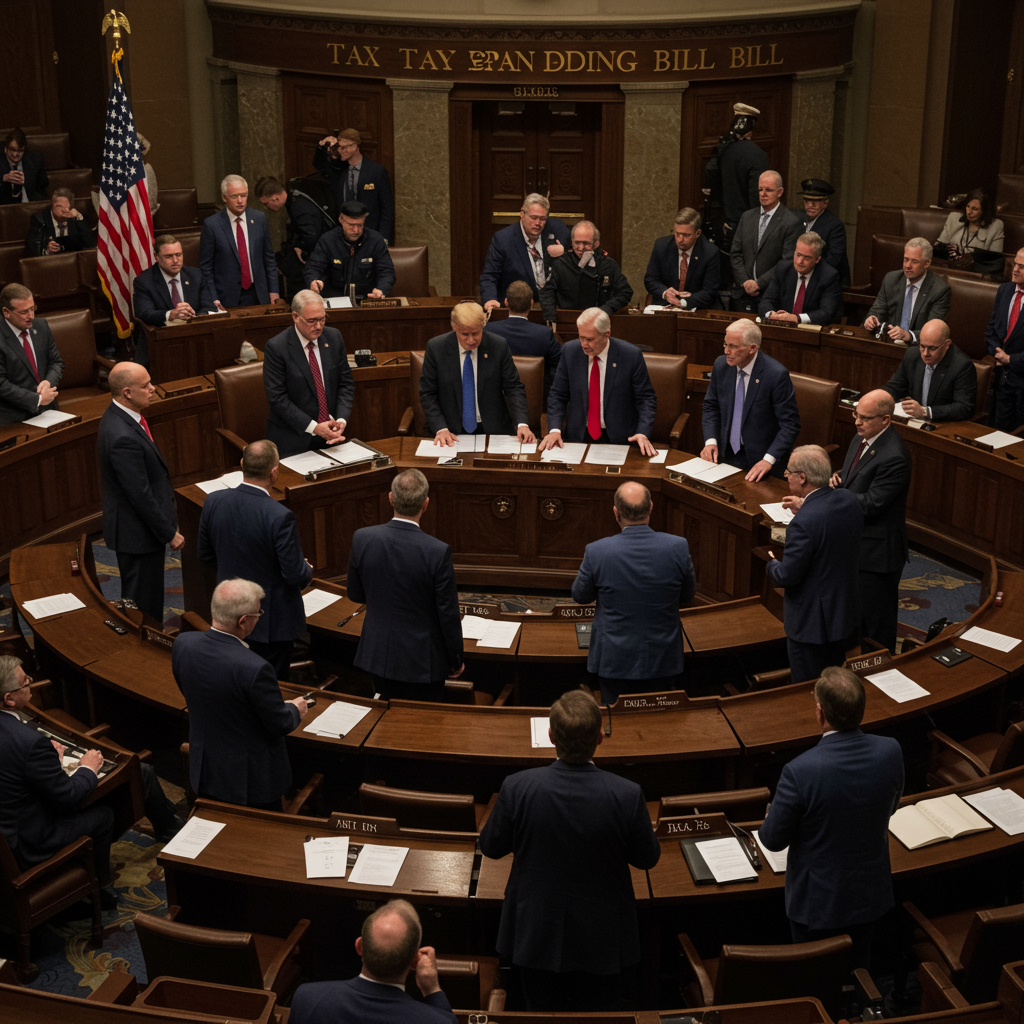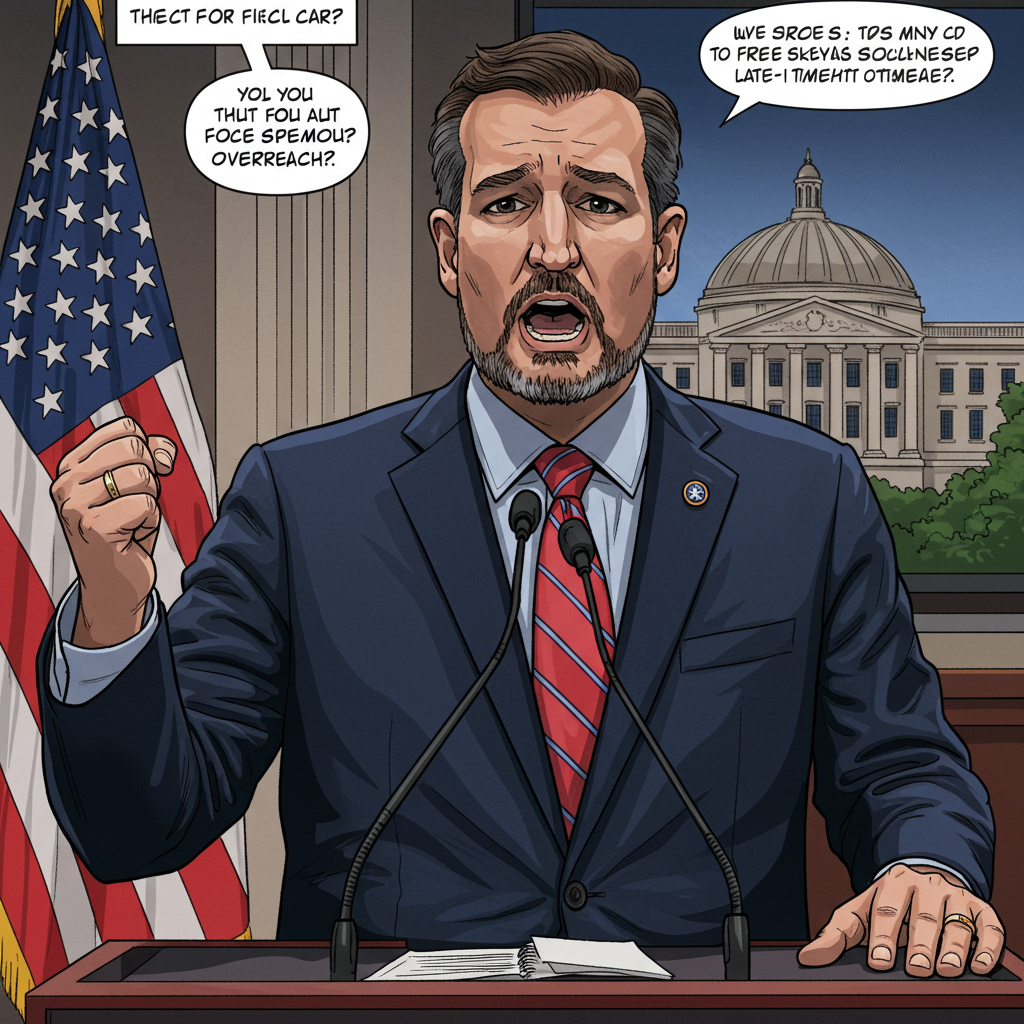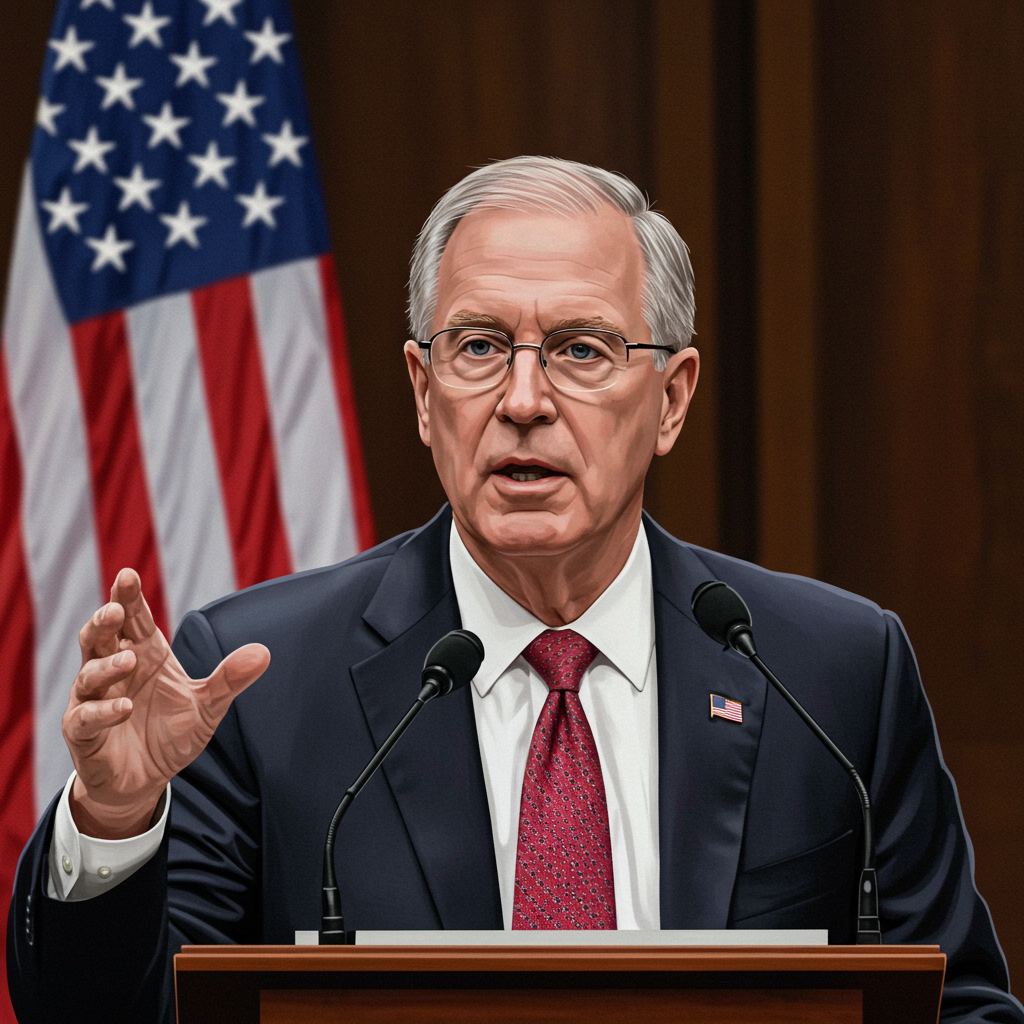In a dramatic late-night session, senate republicans took a critical step forward on President Donald Trump’s sweeping legislative package. The move occurred Saturday evening, as lawmakers raced against a looming July Fourth deadline set by the President. This procedural vote clears the way for intense debate on a bill packed with significant tax cuts, extensive spending reductions, and bolstered funding for immigration enforcement.
The Tense Saturday Night Vote
The Senate floor became the center of political tension during a rare Saturday evening session. Republicans pushed to advance President Trump’s ambitious “One Big Beautiful Bill Act” despite internal divisions and unified Democratic opposition. A key procedural vote, the motion to proceed with the legislation, narrowly passed by a tally of 51-49.
Vice President JD Vance was present at the Capitol, ready to cast a tie-breaking vote if necessary. The session saw voting come to a standstill for over three hours. Holdout senators huddled in negotiations and took private meetings off the floor. When the roll call finally concluded, two Republicans ultimately voted against the motion to proceed, aligning with all Democrats. Senator Thom Tillis of North Carolina cited “grave Medicaid cuts” as his reason for opposition, fearing the impact on healthcare in his state. Senator Rand Paul of Kentucky opposed a provision to raise the nation’s debt limit by $5 trillion. Senator Ron Johnson of Wisconsin initially voted no but switched his vote to yes after private discussions. Attention also focused on Senator Lisa Murkowski of Alaska, who voted to proceed following intense conversation with GOP leaders.
Unpacking the “One Big Beautiful Bill Act”
At 940 pages, the legislation is a complex blueprint of Republican priorities. Its core aims to make permanent many of the tax breaks enacted during Trump’s first term, which are set to expire. Without congressional action, many Americans could face a tax increase by year’s end. Nonpartisan analysis from the Congressional Budget Office (CBO) estimated the tax provisions alone would cost roughly $3.8 trillion over a decade under the House version.
The bill proposes extending existing tax rates and brackets. It also introduces several new temporary tax breaks. These include eliminating taxes on tips, overtime pay, and certain automotive loans. The Senate draft adds a larger deduction for older adults and increases the child tax credit. A significant, albeit temporary, compromise addresses the State and Local Tax (SALT) deduction cap. The bill proposes raising the current $10,000 cap to $40,000 for five years.
Funding National Security and Deportation Efforts
A substantial portion of the bill, approximately $350 billion, is allocated to Trump’s border and national security agenda. This funding specifically targets a stated goal of the largest mass deportation operation in U.S. history. Provisions include $46 billion for the U.S.-Mexico border wall and $45 billion for establishing 100,000 migrant detention facility beds. It supports hiring 10,000 new Immigration and Customs Enforcement (ICE) officers, offering significant signing bonuses. New fees would also be imposed on immigrants, including those seeking asylum. Billions more are directed towards the Pentagon, NASA’s Artemis mission, and missile defense systems.
Proposed Spending Cuts and Program Impacts
To offset the considerable cost of the tax cuts and new spending, the bill includes deep reductions to established government programs. These targeted areas include Medicaid, food stamps (Supplemental Nutrition Assistance Program – SNAP), and green energy incentives. Republicans frame these cuts as efforts to reduce waste and “rightsize” safety net programs.
The package introduces controversial requirements, such as an 80-hour-per-month work mandate for many adults receiving Medicaid and food stamps. This includes individuals up to age 65 and parents of children aged 14 or older. A new $35 co-payment for Medicaid services is also proposed. Green energy provisions from the Biden administration, like tax breaks for electric vehicles and renewable energy projects, would be significantly rolled back or eliminated. Estimated savings from cuts to Medicaid, food stamps, and green energy programs total at least $1.5 trillion.
Analyzing the Potential Consequences
Nonpartisan analyses have highlighted the potential impacts of the legislation. The Congressional Budget Office (CBO) projected significant changes to health coverage and food assistance. According to a CBO assessment of the Senate bill, it could lead to an increase of 11.8 million people without health insurance by 2034. An analysis of the previously passed House version indicated at least 3 million fewer people would qualify for food aid.
The CBO also assessed the financial implications for taxpayers. While the House bill analysis suggested top income-earners could see an average tax cut of around $12,000, it indicated a potential cost of $1,600 per year for the poorest individuals. This shift in financial burden has drawn sharp criticism.
Concerns about the bill’s impact extend beyond the CBO numbers. Dissent within Republican ranks centers on the severity of the cuts. Some worry about the effect on vulnerable populations and essential services, particularly the impact of Medicaid reductions on rural hospitals. Fiscal conservatives, conversely, advocate for even deeper cuts to address the national debt, which the bill’s debt limit increase provision also addresses.
Navigating the Challenging Legislative Path
Clearing the procedural hurdle Saturday night was a necessary but difficult step. The bill still faces significant challenges and potential revisions. The legislative process has been complicated by the Senate’s strict Byrd Rule. This rule limits policy provisions in budget bills unless they receive 60 votes, a high bar given the Senate’s narrow 53-47 Republican majority and unified Democratic opposition.
Several initial proposals, including shifting food stamp costs to states or altering the funding structure of the Consumer Financial Protection Bureau, were deemed non-compliant with the Byrd Rule. Republicans have had to revise these provisions quickly to meet the rule’s requirements and reinsert them into the bill. Despite clearing this procedural step, the bill is expected to undergo extensive debate and amendment votes in the Senate. If it passes there, it must return to the House for a final vote before potentially reaching the President’s desk.
President Trump has been actively pushing for the bill’s passage, publicly urging Congress to wrap it up. The White House released a statement strongly supporting the legislation. However, Trump has also reportedly lashed out at GOP holdouts, even threatening to campaign against one senator. This pressure highlights the high stakes the administration has placed on this signature domestic policy initiative.
Opposition and Internal Divisions
Democrats remain united in their opposition to the bill. Senate Minority Leader Chuck Schumer criticized Republicans for releasing the lengthy text “in the dead of night” and rushing the process. He argued the public needed more time to understand the bill’s contents fully. Schumer also forced a full reading of the bill text on the Senate floor, a move expected to take hours and delay proceedings.
Republican divisions, though not enough to stop the procedural vote, remain a hurdle. As noted, Senators Tillis and Paul opposed the initial motion for distinct reasons related to Medicaid cuts and the debt limit. Even those who ultimately voted yes, like Senator Johnson, did so only after significant negotiation. External criticism has also emerged, with billionaire Elon Musk publicly calling the package “utterly insane and destructive.” The blend of tax cuts, spending increases, and deep program reductions creates a complex balancing act that not all Republicans fully support.
Key Compromises and Remaining Hurdles
The latest version of the bill includes some notable compromises aimed at addressing concerns and navigating parliamentary rules. The controversial Medicaid provider tax cuts were revised. The new version extends the start date for these cuts and establishes a $25 billion fund specifically to aid rural hospitals and providers potentially impacted.
The compromise on the SALT deduction cap, raising it temporarily to $40,000, is another example. This addresses a priority for lawmakers in high-tax states. However, it hasn’t fully satisfied either side; some Republicans believe it’s too generous, while House Republicans had sought a longer duration. These points indicate that further negotiations and potential changes may be needed as the bill moves forward.
Frequently Asked Questions
What are the main provisions included in President Trump’s bill?
The “One Big Beautiful Bill Act” combines several key Republican priorities. It aims to make permanent many existing tax breaks from the Trump administration and adds new, temporary tax cuts. It allocates significant funding, around $350 billion, to national security and immigration enforcement, including building a border wall and increasing deportation capabilities. To offset these costs, it proposes major spending cuts to programs like Medicaid, food stamps (SNAP), and green energy incentives, totaling at least $1.5 trillion in estimated savings. The bill also includes various other provisions, from funding for rural hospitals to changes in the SALT deduction and a $5 trillion increase in the national debt limit.
How do cost estimates for the bill differ?
The total cost of the bill’s tax provisions is a point of contention. The nonpartisan Congressional Budget Office (CBO) estimated the House-passed version’s tax cuts would cost approximately $3.8 trillion over a decade, adding $2.4 trillion to deficits. Senate Republicans use a different accounting method, treating the extension of existing tax breaks as “current policy,” which reduces their estimated cost for the tax provisions to around $441 billion according to the Joint Committee on Taxation. Critics argue this method understates the true cost, with some estimates placing the total tax cost closer to $4.2 trillion over ten years. The varying estimates reflect different ways of accounting for the continuation of expiring policies.
Why is the bill facing opposition, even from Republicans?
The bill faces opposition from Democrats due to its deep spending cuts, particularly to safety net programs, and the rapid process used to advance it. Even within the Republican party, there is dissent. Some lawmakers worry about the impact of cuts to Medicaid and food stamps on vulnerable constituents and essential services like rural hospitals. Others are concerned about the bill’s provision to increase the national debt limit by $5 trillion. Fiscal conservatives may also push for deeper cuts than currently proposed. This mix of policy disagreements and concerns about specific provisions has made it challenging for Republican leadership to unite their narrow majorities.
Conclusion
Senate Republicans have cleared a crucial hurdle for President Trump’s massive legislative package. The narrow procedural vote on Saturday night signals the bill will now proceed to open debate. However, its path forward remains fraught with challenges. Deep divisions persist, both between Republicans and Democrats and within the Republican party itself. The bill’s blend of tax cuts, spending increases, and reductions to core programs faces scrutiny over its potential impacts on healthcare, food security, the environment, and the national debt. As the July Fourth deadline approaches, the Senate faces intense pressure and complex negotiations to determine the fate of this signature Republican initiative.
Word Count Check: 1210



